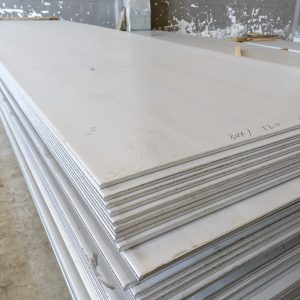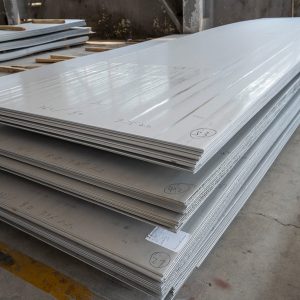
Stainless steel has become an indispensable material across various industries owing to its durability, corrosion resistance, and aesthetic appeal. Among the different grades available, 304 stainless steel sheets stand out as one of the most versatile and widely used options. This comprehensive guide aims to unlock the advantages of 304 stainless steel sheets, exploring their properties, applications, and benefits in detail.
Introduction to 304 Stainless Steel Sheets
304 stainless steel is an austenitic stainless steel that contains a high amount of chromium (around 18%) and nickel (around 8%). These elements contribute to its excellent corrosion resistance and formability, making it ideal for a broad spectrum of applications.
What is 304 Stainless Steel?
| Property | Description |
|---|---|
| Grade | 304 (also known as 18/8 stainless steel) |
| Composition | Approximate percentages: 18% Chromium, 8% Nickel, 2% Manganese, Small amounts of Carbon, Silicon, and other elements |
| Type | Austenitic (non-magnetic in annealed condition) |
| Standard | ASTM A240, EN 10088-2 |
Common Forms of 304 Stainless Steel Sheets
- Cold Rolled Sheets: Smooth surface, high precision, used in decorative applications.
- Hot Rolled Sheets: Thicker, more economical, used in structural applications.
- Embossed and Patterned Sheets: For decorative purposes.
Properties of 304 Stainless Steel Sheets
Understanding the properties of 304 stainless steel sheets is vital for appreciating their advantages.
Mechanical Properties
| Property | Typical Value | Notes |
|---|---|---|
| Tensile Strength | 505 MPa (73 ksi) | High strength for various applications |
| Yield Strength | 215 MPa (31 ksi) | Ensures structural stability |
| Elongation | 40-60% | Excellent ductility |
Corrosion Resistance
- Resistant to oxidation and corrosion in a variety of environments, including rust, acids, and alkaline solutions.
- Performs well in marine, industrial, and domestic environments.
Thermal Properties
| Property | Value | Notes |
|---|---|---|
| Melting Point | 1,400–1,450°C | Suitable for high-temperature applications |
| Thermal Conductivity | 16.2 W/m·K | Good heat transfer capabilities |
Other Key Properties
- Formability: Excellent, allowing for bending, shaping, and forming.
- Weldability: Good weldability with standard welding techniques.
- Hygienic: Non-porous surface easy to clean, suitable for food and medical industries.
- Aesthetic Appeal: Bright, shiny surface that can be polished to a mirror finish.
Advantages of 304 Stainless Steel Sheets
The widespread adoption of 304 stainless steel sheets is driven by their multiple advantages, which we will explore in detail.
1. Superior Corrosion Resistance
Thanks to its high chromium content, 304 stainless steel forms a passive oxide layer that prevents corrosion. This makes it suitable for environments exposed to moisture, chemicals, and varying temperatures.
2. Excellent Formability and Weldability
304 sheets can be easily bent, shaped, and welded without compromising their strength or integrity. This flexibility simplifies manufacturing processes and enables complex designs.
3. High Durability and Longevity
The material’s corrosion resistance combined with its mechanical strength ensures a long service life even under harsh conditions.
4. Aesthetic and Surface Finish
304 stainless steel sheets have a bright, attractive appearance. They can be polished to achieve mirror finishes or brushed for a matte look, making them ideal for decorative applications.
5. Hygienic and Easy to Clean
The non-porous surface prevents bacteria and dirt accumulation, making 304 stainless steel perfect for food processing, medical equipment, and kitchen appliances.
6. Cost-Effective and Widely Available
Compared to other stainless steel grades, 304 offers a good balance of performance and affordability, with widespread availability in various forms and thicknesses.
Applications of 304 Stainless Steel Sheets
The versatility of 304 stainless steel sheets allows for their use in numerous sectors.
| Industry | Typical Applications |
|---|---|
| Food & Beverage | Kitchen equipment, food processing machinery, dairy tanks |
| Medical | Surgical instruments, hospital fixtures |
| Architecture | Cladding, handrails, decorative panels |
| Automotive | Exhaust systems, trim components |
| Industrial | Storage tanks, piping, chemical containers |
| Home Appliances | Refrigerators, sinks, cookware |
Comparative Analysis: 304 vs Other Stainless Steel Grades
Understanding how 304 compares with other grades helps in selecting the right material for specific needs.
| Feature | 304 Stainless Steel | 316 Stainless Steel | 430 Stainless Steel |
|---|---|---|---|
| Corrosion Resistance | Good | Excellent (better in chloride environments) | Moderate |
| Cost | Moderate | Higher | Lower |
| Magnetic Properties | Non-magnetic | Non-magnetic | Magnetic |
| Typical Uses | General-purpose, food, medical | Marine, chemical, high-corrosion environments | Decorative, appliances |
Manufacturing and Fabrication Considerations
Cutting and Shaping
- Suitable for laser cutting, plasma cutting, water jet cutting, and shearing.
- Maintain proper parameters to avoid warping or damaging the surface.
Welding
- Can be welded using TIG, MIG, or spot welding.
- Post-weld cleaning enhances corrosion resistance.
Surface Finishing
| Finish Type | Description | Suitable For |
|---|---|---|
| Mirror Finish | Highly reflective surface | Decorative, architectural |
| Brushed Finish | Satin appearance | Appliances, interior design |
| Matte Finish | Non-reflective | Industrial applications |
Maintenance and Care Tips
To maximize the lifespan and aesthetic appeal of 304 stainless steel sheets:
- Regular cleaning with mild soap and water.
- Avoid using abrasive cleaners that can scratch surfaces.
- For stubborn stains, use non-abrasive, stainless steel-safe cleaners.
- Periodic polishing to restore shine if needed.
- Ensure proper sealing in highly corrosive environments.
Cost Analysis and Market Trends
| Aspect | Details |
|---|---|
| Price Range | Varies based on thickness, size, and finish, typically $2 – $10 per pound |
| Market Demand | Growing in construction, automotive, and medical sectors |
| Future Trends | Increased use in sustainable architecture, eco-friendly manufacturing |
Summary: Why Choose 304 Stainless Steel Sheets?
| Advantage | Explanation |
|---|---|
| Versatility | Suitable for a broad range of applications due to excellent properties |
| Durability | Long-lasting even in challenging environments |
| Aesthetic Appeal | Easily polished or textured for decorative purposes |
| Cost-Effectiveness | Widely available at competitive prices |
| Hygiene & Safety | Non-porous, easy to clean, ideal for food and medical industries |
Conclusion
Unlocking the full potential of 304 stainless steel sheets reveals their importance across multiple sectors. Their combination of corrosion resistance, mechanical strength, aesthetic flexibility, and affordability makes them an optimal choice for countless applications. Whether in construction, manufacturing, or culinary settings, 304 stainless steel sheets continue to provide unmatched benefits, cementing their status as a cornerstone material in modern industry.References
- ASTM A240/A240M – Standard Specification for Chromium and Chromium-Nickel Stainless Steel Plate, Sheet, and Strip for Pressure Vessels and Reactors.
- EN 10088-2 – Stainless steels — Part 2: Technical delivery conditions for sheet/plate and strip of corrosion resisting steels.
- “Stainless Steel: Types, Properties, and Applications,” ASTM International.
- “Corrosion Resistance of Stainless Steel,” Nickel Institute.
- Market research reports on stainless steel industry trends.
Note: This guide is intended to provide a detailed understanding of 304 stainless steel sheets. For specific applications or technical advice, consulting with a materials engineer or supplier is recommended. PDF Download:Download




